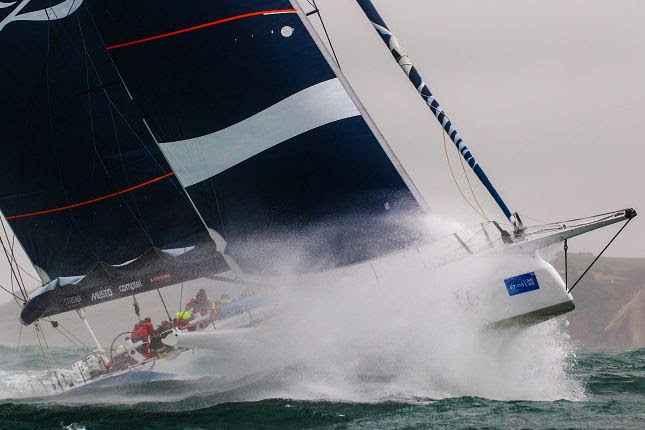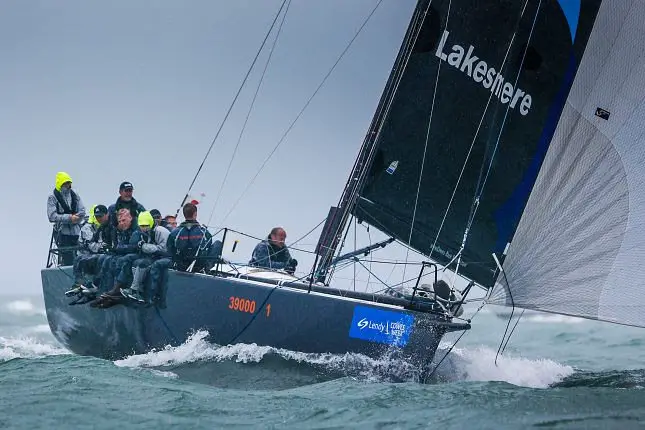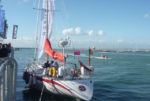Thanks to Rupert Holmes of Cowes Week Limited for this Day 3 round-up report from Lendy Cowes Week. Ed
Wednesday was one of fast and furious action at Lendy Cowes Week.
John Hamilton, bowman on Stewart Whitehead’s Rebellion, which finished third in the Fast40+ class, said,
“On the way out to the start it looked like the Apocalypse was coming, and with a short course, there were a lot of corners coming up really fast.
“We had two short legs when we had to peel from the Code Zero to the spinnaker, so it was very challenging but we love that. On the bow it was like a submarine at times, I was getting soaked to the bone, stinging spray in my face, a proper hosing! The finish was amazing, we gybed for the line side by side with Pace and just hung on – it was a thrill to win that battle.”
Celebrity action and broken records
The first starts were for the 23 big yachts competing in the Sevenstar Triple Crown, making for a spectacular sight. The largest yachts, including the seven entries in the 2017/8 Volvo Ocean Race, were racing around the Isle of Wight, with their navigation data predicting the world record for the course would fall.
With one reef in the mainsail and staysail set Ludde Ingvall and Sir Michael Hintze’s 100ft foiling supermaxi CQS started powering up 30 seconds before the gun, before speeding away out of sight, on her way around the Isle of Wight, followed by a trail of spectator RIBs.
On board were celebrity Jodie Kidd and Liam Brooke, co-founder of Cowes Week title sponsor Lendy.
Jodie said,
“It was amazing, tough conditions and we had some issues, which was a bit of a shame.
“It was an unbelievable experience – we were given quite a rough ride round the back of the Island and I felt I was part of the team on the rail.”
This was also the first time the seven teams competing in the 2017/8 Volvo Ocean Race lined up against each other. They took a much more aggressive approach to the line, with Spanish entry Mapfre a nose ahead at the gun. She accelerated away to a two-length lead immediately after the start, with Turn the Tide and Brunel in hot pursuit.
CQS was at the Needles 50 minutes after her start, with the Volvo Ocean Race yachts already eroding her lead on the water. At this time it appeared to observers that the fleet was outside record time at this stage, but at 1110 navigators on board confirmed they were already ahead of projections, despite a brutal sea state thanks to gust of 40 knots in wind against tide conditions.

CQS, Maxi Racer © Tom Gruitt
Half an hour later they were past Ventnor, with Mapfre now leading the entire fleet and hitting speeds well in excess of 25 knots. They maintained this speed past Bembridge, so the big question then was whether the wind in the Solent, which at this stage was still mostly below 15 knots would build for their final leg to the finish.
She was still hitting more than 20 knots after passing the forts between Seaview and Portsmouth, followed only a few hundred metres back by Team Brunel, Dongfeng Race Team and Team AzkoNobel. Drawing a little further ahead of her competitors as she blasted through the windward/leeward course of IRC Class 5.
Off Osborne Bay Mapfre was still maintaining 18 knots with more than 15 minutes left to finish within the record time, so now the only question was how she would fare in Norris Nadgers, the infamous area of gusts and wind holes in the lee of the high ground off East Cowes.
As she came within sight of race officials on the Royal Yacht Squadron’s platform it was clear that she would be within the record time. What was not apparent at that time, however, was that the next three boats would also finish inside the time set in 2013 by Mike Slade’s 100ft ICAP Leopard.
Mapfre completed the 50-mile course around the Isle of Wight in 3 hours, 13 minutes and 11 seconds, setting a new outright Around Isle of Wight world record by a monohull yacht, beating Slade’s time by 6 minutes 58 seconds. Unlike the Volvo Ocean 65s, ICAP Leopard has powered winches. Mapfre therefore also beat the previous world record for a monohull without power assistance by an impressive margin of more than 36 minutes. Both records are subject to ratification by the World Speed Sailing Record Council.
Skipper, Xabi Fernandez, said,
“We did a very good start and the manoeuvres were all very good – it’s one of our strongest points we have as a crew.
“A lot of us have sailed together already and the new people are all good, very switched on, and things are coming together nicely.
“We had a good start, were able to control the fleet a bit, and then we were always in the lead. It was a very close race with the other boats, there were some very fast moments, and it was great fun.”

Mapfre, Volvo Ocean 65 © Tom Gruitt
White Group
The White Group dayboat classes had their first starts heading east from the Royal Yacht Squadron line, on a white sail reaching course in the southerly wind. Even though they had an adverse tide many started prematurely. A band of rain came through just before the Etchells start at 1025, making for a tricky start, balancing less adverse tide inshore against the big wind holes close in under the lee of the Royal Yacht Squadron.
Phoebe Connellan’s youth team on Mano, and Murray Chapples’ Silver Lining led the fleet towards the line with a minute to go, encouraging the rest of the fleet to close the line and pull the trigger to accelerate too early. Four boats started prematurely, but only Mano returned, leaving another youth team, Oli Aldridge’s Sumo, along with Charles Glanville’s Palaver and Tom Abrey’s Jolly Roger to be scored OCS.
Rob Tyrwhitt-Drake’s Desperate led the fleet from a windward position as they crossed the mouth of the River Medina, with Shaun and Emily Frohlich’s Exabyte a couple of lengths back and to leeward.
At the end of their nine-mile predominately windward/leeward course Rob Elliot’s Bon Vivant took his third win of the week, 27 seconds ahead of Exabyte. Silver Lining and Desperate had the closest of tussles for third place, with the former clinching it by just one second.

Etchells Fleet © Paul Wyeth
Starting at 1035, the Daring fleet was tightly bunched on the line but got away with a clean start. 30 seconds before the gun the series leader, John Corby’s Doublet, started accelerating through the fleet, hoping to overtake the Snagge, Sichel, Pegna and Gatehouse team on Darling to leeward but failed to get into clear air.
David Gower, Jamie Clark and Peter Haworth’s Dolphin made a well timed approach, half a length ahead of the pack and in clean air when the smoke from the starting cannon cleared. Starting inshore, Andrew Norton’s Decoy picked up a useful gust and was first into the stronger breeze at the mouth of the Medina.
Doublet took her fourth win of the week, ahead of Dolphin and Decoy.
Corby said,
“Overall we are looking strong but it’s definitely not over yet.
“Over the last three years the standard of fleet has really improved – it’s definitely not easy to score a top result.
“There was a navigation question over which side to pass the moorings just east of the start, so we decided to sail north of them all to be sure. It was tough out there and a tricky helming job but Andy McLellend did a superb job of weaving through Norris Nadgers, the most difficult part. It was really fluky and it was there where I think we gained the most.
“It was windy, that’s for sure with gusts close to 30 knots, so once we’d taken the lead we slotted into boat preservation mode because it was really on the edge. To be honest, in those conditions we would have been happy with a second.”
At the start of the day race officials had feared they might need to cancel racing for some of the later starting fleets among the White Group dayboats, but as the morning progressed it became clear that the strongest gusts were at that stage staying to the south and west of the race area, enabling racing to be run for all classes, with the exception of the Sunbeam and Swallow fleets whose classes opted to stay ashore.

Daring Fleet © Paul Wyeth
Black Group
The smaller boats racing closest to the central Solent were spared the worst of the strong winds until the early afternoon, when the gusts suddenly started spiking over 35 knots. However, the strong winds reached the larger boats racing in the eastern and western Solent at an earlier stage. Along with the other Black Group classes that started on the Bramble line, the Sigma 33 class therefore had their course shortened.
Jeff Worboys’ Workout had been dominating this class, with three wins and one second place in the first four races. However, after a close race in testing conditions, Allan Fraser’s Prospero of Hamble took the winner’s gun by a margin on just eight seconds. Toby Gorman’s Stan the Boat finished third, less than two minutes after Workout.
IRC Class 4 has been particularly closely fought this year. After their first four races only one point separated the top three boats – Peter and Sarah Hodgkinson’s X362 Sport Xcitable, David Franks’ JPK 10.10 Strait Dealer, and Oliver Legrain’s Archambault 35 IBA Sailing Team.
The race saw Strait Dealer take her second win of the series, 28 seconds ahead of IBA Sailing Team, while Xcitable took third almost three minutes later. This leaves Strait Dealer now leading the fleet on 11 points, with Xcitable and IBA Sailing Team tied on 13 points. All three are well ahead of Mike Moxley’s HOD 35 Malice, in fourth place overall with 29 points.
By contrast, there’s a clear leader in IRC Class 5, with Harry Heijst’s Sparkman and Stephens 41 Winsome eight points clear of Nick Munday’s J/97 Induljence. In turn, he had a 3.5 point cushion on another J/97, Bob and John Baker’s Jaywalker in third overall.
Another clear win for Winsome cements her class lead. Jean-Francois Nouel’s Sunfast 3200 SNSP Hakuna Matata took second place for the second day running, while Mike Sellers and Chris Miles’ J/97 Jet was third.
A closely fought match for fourth place saw four boats separated by only 50 seconds. They were led by another J/97, James and John Owen’s Jet, while Induljence suffered her worst result so far in sixth place.
Youth Day
Lendy Cowes Week actively supports and encourages the next generation of sailors, as do many of the classes that actively encourage, support and coach young sailors, including J/70s, Swallows, Etchells, Squibs and Redwings. It was the regatta’s Youth Day, which highlights the success of the many young sailors at the event.
This year there are 29 teams in which the entire crew is under 25. In the rankings for the Under 25 trophy Freddie Peters’ RS Elite Riff Raff tops the leaderboard, ahead of Hugo Mills’ Mermaid Sheen. Ollie Smyth’s Sonata Joey is third, just ahead of last year’s winner, Jack Davies’ J/70 Yeti.
The regatta’s official charity, the Andrew Simpson Foundation appointed seven experienced dinghy sailors – Drew Gibson, Abi Clarke, Cameron Tweedle, Callum Dixon, Catherine Hunt, Edward Higson and Anthony Pinke – as youth ambassadors. All were selected for their understanding of how much of a positive impact sailing can have on young people’s lives and for showing an interest in helping to promote sailing to a wider audience. The Foundation also organized a Careers Cafe at the Shepards Wharf Sugar Store, highlighting the opportunities available to young people in the marine industry.
Image: © Zero II – Cowes Race School, IRC Class 1 © Paul Wyeth





